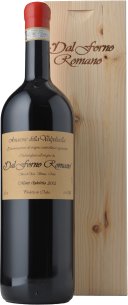Château l'Eglise-Clinet Pomerol
Château l'Eglise-Clinet is a much sought after Domaine within the right bank district of Bordeaux and can be hard to come by. A majority blend of Merlot to Cabernet delivers a wine of subtlety and plushness and due to the properties long planted vines, the ageability is second to none in the region. After not pulling out vines after the 1956 frost, this Château can boast some of the oldest vine material in Pomerol and that evidence can be found in the 2003 bottle of l'Eglise-Clinet which is still ageing gracefully in the bottle even after a difficult vintage due to heat.
Domaine Mongeard-Mugneret Grand Cru
One of the finest and most ethereal of all Burgundies, Domaine-Mugneret Grands-Échézeaux comes from a small 1 hectare plot of old vines averaging in age between 40 and 70 years. Silky and intense with a beguiling perfume of violets, fresh cherries, earth, leather, forest floor and truffle, the wine shows lovely volume and density with the structure to age gracefully over many years.
Bouchard Pere & Fils Grand Cru
Bouchard owns two parcels at the top and bottom of the famed walled vineyard, although presently their Clos de Vougeot Grand Cru comes from the top part, as the bottom has been pulled up. This part of this famous, 50 hectare walled vineyard tends to produce the best wine that have Grand Cru concentration and structure.
Chateau de la Tour Vieilles Vignes
CHATEAU DE LA TOUR Vieilles Vignes, Clos de Vougeot
Clarendon Hills Astralis Syrah
Clarendon Hills is the living vision of one of the world's greatest Shiraz winemakers, Roman Bratasiuk. The dream was realised in 1990 and is now home to some of the most outstanding and hard to get single vineyard wines in Australia. The Astralis is the flagship wine in the Clarendon Hills portfolio, and while this vineyard is not treated any differently to the others, it garners the most worldwide attention due to its incredible expression and timeless elegance. From an Easterly aspect and planted on a 45 degree ascending slope, Australis has phenomenal varietal length and will repay the patient cellarer for more than 15 years.
Château Angélus Saint-Emilion
A very important estate in St-Émilion, Château Angélus was acquired by the de Boüard de Laforest family in 1924 and merged with the previously owned Château Mazerat. The apostrophe was dropped in 1989 and is now simply known as Angélus. The wines are characterised by a fabulous texture offered by the high component of Cabernet Franc with the plump softness added by the Merlot creating a wine of pleasing plushness.
Bass Phillip Reserve Pinot Noir
Australian Pinot Noir does not get any better than the wines produced by Phillip Jones at the iconic Bass Phillip winery. A Pinot Noir of utmoust power and elegance, the rival to any great Burgundy. Rated in the top classification in Langton's Classification of Australian Wine, Bass Phillip Pinot Noir is riddled with complex flavours of strawberry, violets, rose petal and forest floor. The length of palate is immortal.
Château Cheval Blanc Saint-Émilion
Without a doubt one of Bordeaux's most famous vineyards, Cheval Blanc lies on the border of Pomerol and is also easily the most important estate in St-Émilion. Uniquely a blend dominated by Cabernet Franc, Cheval Blanc's wines have a powerful bouquet which is spicy and rich which is followed by fruit that is soft, mellow and liquorous. Matched only by Pétrus in the realm of vigour and concentration, Cheval's exuberance is not to be missed. With this latest release, the 2009, the wines are bordering on immortal. A blend of 60% Merlot and 40% Cabernet Franc, this super-smooth, velour textured and opulent red wine shows rambunctious flavours of raspberries, blueberries, liquorice and a smidge of menthol. Will be fascinating to watch this































